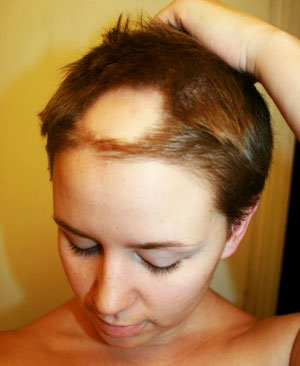Alopecia (hair loss) - types, causes, symptoms and treatment

Alopecia is the clinical term for HAIR loss. There are numerous forms and causes of alopecia, which may be localized or widespread, temporary or permanent. Though alopecia is emotionally traumatic for many people, it does not affect health in any way though may reflect underlying health conditions. Common forms of alopecia include the following:
- Androgenic alopecia, or male pattern hair loss, in which a man’s hairline recedes from the temples and forehead and thins on the crown in a characteristic pattern that may culminate with a fringe of hair remaining along the sides and back of the head. Hair loss is permanent. Androgenic alopecia is hereditary and commonly begins in midlife, though may begin as early as a man’s mid-20s. Researchers believe androgenic alopecia results from a combination of genetic predisposition and naturally declining TESTOSTERONE levels.
- Female pattern alopecia, in which a woman’s hair gradually thins on the top and sometimes back of her head. Hair loss is permanent. Researchers believe female pattern alopecia results from hormonal changes (loss of ESTROGENS and testosterone) that occur following MENOPAUSE.
- ALOPECIA AREATA, an autoimmune disorder in which the body’s IMMUNE RESPONSE attacks clusters of hair follicles, temporarily impairing their ability to produce new cells. Alopecia areata may affect any part of the body and occasionally the entire body. Hair loss is temporary, though may be long term.
- Toxic alopecia, which results from exposure to substances that impair the ability of the hair follicles to generate new cells. The most common sources of such exposure are radiation therapy and chemotherapy treatments for cancer. Other causes include vitamin A toxicity and medication side effects, such as from retinoid preparations to treat acne. The extent of hair loss depends on the toxic agent, ranging from localized (such as with radiation therapy to the head) to nearly complete (such as with chemotherapy). Hair growth returns when the toxic exposure ceases.
Scarring, such as occurs as a result of BURNS, wounds, and certain AUTOIMMUNE DISORDERS, destroys the hair follicles so hair loss in such areas is permanent. Conditions and circumstances that damage but do not destroy the follicles often allow hair growth to resume. Medical treatments that stimulate follicle activity can accelerate the return of hair in many such situations.
| CONDITIONS ASSOCIATED WITH ALOPECIA | |
|---|---|
| radiation exposure | CHEMOTHERAPY |
| TRICHOTILLOMANIA | tinea capitis |
| PREGNANCY | MENOPAUSE |
| HYPOTHYROIDISM | high FEVER |
| INFECTION or serious illness | scars from wounds or BURNS |
| excessive hair care and styling | SUNBURN and sun exposure |
| AUTOIMMUNE DISORDERS | DISCOID LUPUS ERYTHEMATOSUS (DLE) |
| hormonal changes | SYSTEMIC LUPUS ERYTHEMATOSUS (SLE) |
| MALNUTRITION | hair coloring and styling products |
| stress | FOLLICULITIS |
Symptoms of Alopecia and Diagnostic Path
Hair loss is the primary symptom of alopecia. The pattern and rate of hair loss help determine the nature of the underlying cause. When alopecia is male pattern or female pattern hair loss, the doctor can make the diagnosis on the basis of appearance. When the cause of hair loss is uncertain, the doctor may biopsy several sites on the scalp, both with and without hair, for microscopic examination. A comprehensive health history and medical examination are important to identify any potential systemic or general health causes for hair loss. Preliminary findings determine what, if any, further testing is necessary.
Alopecia Treatment Options and Outlook
Treatment first targets any underlying condition that may be responsible for hair loss. In many situations of alopecia related to other health conditions, hair growth will resume without medical intervention. People who are sensitive about their appearance during the period of temporary alopecia may choose to wear hairpieces, hair weaves, wigs, scarves, or hats until their hair returns. Topical products to stimulate hair growth, such as minoxidil (Rogaine) and finasteride (Propecia), sometimes hasten the return of hair follicle function. Such products are often the first choice of treatment for male or female pattern hair loss as well as many forms of nonscarring alopecia. However, hair growth typically continues only for as long as treatment continues.
Minoxidil and finasteride can cause serious BIRTH DEFECTS when they enter the system of a woman who is pregnant. Women of childbearing age generally should not use or handle these products.
Hair replacement methods surgically relocate scalp SKIN with abundant, productive hair follicles to areas of the scalp where there is hair loss. Though these methods cannot restore hair growth to its previous patterns and thickness, they can provide satisfactory results for many people. The color and consistency of the hair influences the success of hair replacement. As well, the scalp must contain adequate areas of productive hair follicles to serve as donor sites.
Alopecia Risk Factors and Preventive Measures
Risk factors for alopecia include AUTOIMMUNE DISORDERS, toxic exposures, stress, heredity, and aging. Efforts to maintain healthy skin help support productive hair growth though cannot prevent most forms of alopecia. Treating any underlying condition that causes alopecia often results in the return of hair.
See also FOLICULITIS; HIRSUTISM; LICHEN PLANUS; SCAR; STRESS AND STRESS MANAGEMENT; TINEA INFECTIONS.